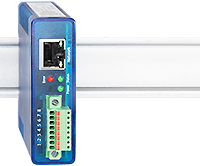Topic:
PoE – Power over Ethernet
Power supply directly from the network cable
Power over Ethernet refers to a technology in which the supply voltage for a network component is included on the data cable. With PoE you can significantly reduce the cabling effort, especially for devices in industrial and home automation. In addition, the additional power supplies often needed for powering devices are eliminated.
PoE power classes
To accommodate the various power requirements of PoE terminal devices, four PoE power classes are defined. Later came the PoE+ and PoE++ standards with an additional five PoE classes. Special power sourcing equipment is used in the form of PoE switches and injectors.
When selecting suitable power feed devices it is important that the maximum power class be compatible with that of the connected PoE terminal devices. The required power is negotiated with the connected terminal device within the possible limits when the device is turned on.
There are two methods:
PoE Switch (PoE Endspan)
Special switches allow connection of standard Ethernet components as well as connecting and powering PoE terminal devices, also referred to as Powered Devices, abbreviated PD.
PoE Injector (Midspan method)
To be able to operate PoE terminal devices in existing networks, it is possible to insert PoE injectors between the switch and terminal device which provide the needed power.
W&T offers a wide range of network-capable sensor and actuator products with PoE ability.
PoE capable products
-

Web-IO 4.0 Digital
2xIn, 2xOutSending digital switching signals in the network
-

Web-IO 4.0 Analog
2x 0..20mAReading and setting analog control signals in the network
-

Web Thermometer Pt100/Pt1000
Detecting temperature over the network
-

Web-Thermo-Hygrobarometer
Provide temperature, relative humidity and barometric pressure values in the network
-

Web-IO CO2
Detect carbon dioxide concentration in the network